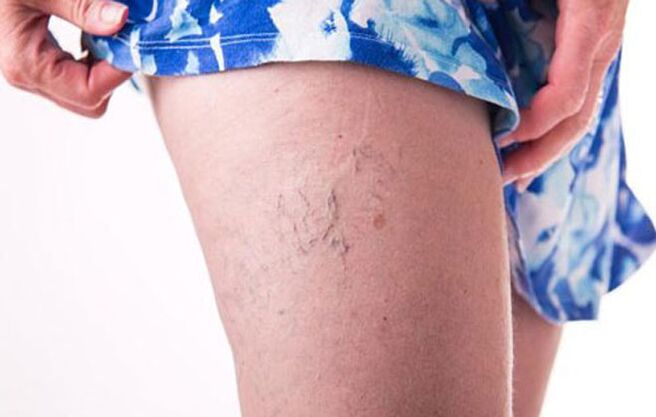
With varicose veins on the legs, symptoms and treatment are associated with each other.This is a widespread vascular disease, accompanied by a weakening of valve Aparage.Everyone heard about varicose veins, and most people have an idea of how dilated vessels look on their feet.But you need to know about the initial signs of the disease and the rules for the prevention of pathology.
Why arises
Varicose disease of the lower extremities develops under the influence of diverse factors.The main causes of pathology:
- Hereditary predisposition.With congenital deficiency of the development of connective tissue, valves suffer.They are not able to perform their functions - to prevent a reverse flow of blood.As a result, stagnation develops, the vessels are expanded and deformed, the likelihood of blood clots increases.
- Features of the Constitution.Excess weight leads to an increased load on the veins.The walls of the vessels become weaker, lose tone and elasticity.The probability of developing pathology in people with excessive body weight increases by more than 33%.
- Life and nature of work.Varicosis appears from a long stay in a standing position, from excessive physical exertion.In women - with frequent use of high -heeled shoes.The causes of varicose veins include the use of tight linen, including a stocking, which leads to compression of large veins in the groin and violation of normal blood circulation of the lower extremities, insufficient physical activity, sitting work in the same position.
- Hormonal balance violation.A change in the number of estrogens and gestagen in human blood can lead to a decrease in blood vessel tone.Prolonged use of hormonal oral contraceptives, the use of drugs during menopause, etc. can provoke a pathology.
- Pregnancy.The growing fruit leads to compression of blood vessels, the development of blood stagnation in the pelvic organs and in the legs.
The establishment of the cause of varicose veins and its elimination will help to avoid the progression of pathology and the development of complications.
Classification
Varicose disease of the lower extremities is found in both women and men.It is characterized by a progressive course in which the following degrees and types of varicose veins on the legs are distinguished:
- Stage of compensation.During this period, the patient does not have complaints about a deterioration in well -being.The initial manifestations - on one or on both legs in the area of the legs, expanded vessels are visualized.
- Stage of subcompensation.There are complaints about pain in the legs, sensation of bursting, convulsions.The legs become swollen, especially by the end of the working day.
- Stage of decompensation.The patient's condition worsens, complications develop - dermatitis, eczema, hyperpigmentation, trophic ulcer.
With varicose veins, the classification includes the following varieties:
- Local defeat.Segmental veins are involved in the pathological process.Reflux (reverse blood) is absent.
- Segmental defeat.A pathological discharge of blood appears in which superficial or communicative veins are involved.
- A common damage to surface veins with reflux.Varicose veins in men are manifested by damage to all superficially located vessels.Most often on both legs at the same time.
- Involvement in the pathological process of deep veins.
Types of varicose veins of the lower extremities according to the international classification:
- Class 0. Lack of complaints and visible manifestations of the disease.
- Class 1. A venous mesh, vascular stars appear.The first complaints about the deterioration of well -being.
- Class 2. Extended blood vessels are visualized under the skin.
- Class 3. As a result of stagnation of blood, swelling of the ankles and legs appears.
- Class 4. Due to circulatory disorders, signs of lipermatosclerosis develop.
- Class 5. The damage to the epidermis occurs, the skin is easily injured, poorly heals.
- Class 6. Trophic ulcers are formed.
Symptoms and signs
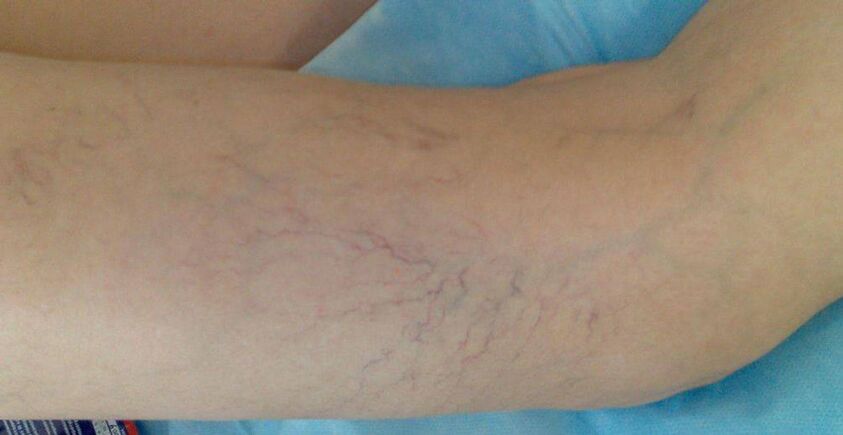
The first signs of varicose veins in women are the appearance of telangiectasius or vascular stars.At first, it is extremely difficult to notice them, since they are single and localized most often on the back of the lower leg or under the knee. After a long stay on the legs or the use of high -heeled shoes, severity and small swelling occur.Varicose veins in men are characterized by the rapid fatigue of the legs.
Gradually, the patient's condition is aggravated, the symptoms of varicose vessels are visible to the naked eye.The veins swell, become winding and bugrous, and cramps appear.The sensitivity of the skin decreases.At night, seizures are not excluded.Swelling is more pronounced.
The expansion of the veins leads to circulatory disorders, the tissues experience a deficiency in oxygen and nutrients.Trophic disorders occur, the skin becomes smooth, shiny, pale.Signs of varicose veins in men - swelling do not pass even after a long holiday.Itching appears, dermatitis.
With severe varicose veins, the symptoms include the formation of non -healing trophic ulcers in the area of the ankles.This threatens the connection of secondary microflora and the development of the infectious and inflammatory process.On the leg, varicose veins is often complicated by the development of thrombophlebitis - inflammation of the vascular walls.A local increase in the temperature in the field of heaves, as well as subfebrilee, is possible.
Diagnostics
Varicose disease is established based on the results of collecting an anamnesis and visual examination of the patient.To clarify the stage of the disease, the prevalence of the pathological process, the features of blood flow, the presence of collaterals, reflux, the condition of the valve apparatus requires an additional examination of the patient.
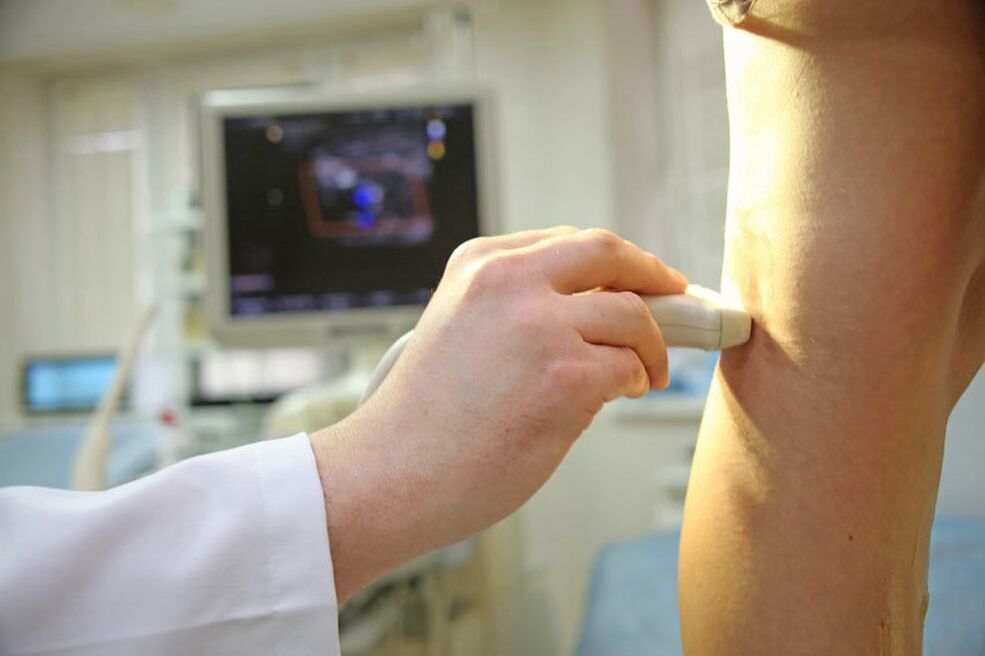
With varicose veins of the lower extremities, it is necessary to make:
- Duplex scanning or ultrasound angioscan.It makes it possible to obtain an image of a blood vessel on its entire length, determine the presence of extensions and reverse blood flow, the condition of the valves.
- Ultrasound of the veins of the lower extremities using a contrast agent.If varicose veins occur, phlebography is necessary to establish obstruction of surface or deep vessels on the legs.The study is required before surgery to determine the method and volume of surgery.
- CT or MRI with contrast.Allows you to get a series of pictures by which the passage of blood vessels, the degree of expansion, the condition of the valve apparatus, the presence of collaterals, etc. are established.
With varicose veins, laboratory tests are necessary in order to evaluate the rheological properties of blood and other indicators.To do this, you need to hand over:
- General blood test.In the presence of an inflammatory process, the erythrocyte settlement rate increases, leukocytes increase.
- A coagulogram, a wolf sovicoagulant, etc. allow us to establish a tendency to increased thrombosis, a state of coagulating and anti -impoverished blood systems.
How to treat
It is necessary to treat varicose veins in men in the legs comprehensively.The therapeutic scheme is developed taking into account the stage of the disease, the prevalence of the pathological process, the presence of complications and other factors.
Conservative methods of treating varicose veins without surgery are used in the initial stages of the disease.With their help, you can stop the progression of pathology, strengthen the walls of blood vessels, increase the tone and elasticity of veins, normalize blood circulation and prevent the development of congestive phenomena.
An important role in the treatment of the disease is played by the use of compression knitwear.Special soil-firing products provide alternating pressure on the entire length of the legs, do not allow blood stagnation, support muscles, and prevent the development of edema.You need to wear them after a night's rest without getting out of bed.Knitwear is selected individually for a person, since each product has a different degree of compression.
Which doctor treats varicose veins
Turn to the doctor with varicose veins on the legs is necessary as early as possible.To do this, you need to find out which doctor treats varicose veins.Therefore, first of all, you should go to the local therapist or family doctor.After the examination, the specialist will give a referral for a consultation to the doctor who treats varicose veins, he is called a phlebologist.This is a narrow specialist engaged in vain diseases.
If a specialized doctor in varicose veins in a clinic or in a hospital is absent, an angiologist or surgeon is engaged in the treatment of all types of vessels pathologies.
If necessary, surgical treatment for varicose veins on the legs should consult a phlebologist or vascular surgeon.In the district hospital, a common profile surgeon is involved in such problems.
How to cure medication
You can cure varicose veins without surgery only in the initial stages of the disease.For this, the following groups of drugs are required:
- Phlebotonics.Affect the condition of the vascular walls.Increase their density, reduce the fragility and permeability of capillaries, increase tone and elasticity, have angioprotective properties.Restore the normal blood flow through the vessels, stimulate the outflow of lymph.
- Anticoagulants and anti -agents.Normalize the rheological properties of blood.Dilige it, prevent blood clots.Used to prevent complications.
- Antioxidants.Accelerate the excretion of toxins and other harmful components from the human body.Beneficially affect the condition of the hematopoietic system.These are ginkgo extracts, multivitamin complexes.
- Anti -inflammatory drugs.They help relieve pain, inflammation, severity, sense of bursting, edema and other unpleasant manifestations of pathology.You need to use them carefully, no longer than 10-14 days.This is due to the fact that the drugs have an adverse effect on the condition of the digestive tract, can cause an exacerbation of peptic ulcer.For VRV, they can be used in the form of a solution for intramuscular injection, tablets for oral use and rectal suppositories.
You need to treat varicose veins for a long time, for several months.Mandatory is taking phlebotonics in the summer, since at this time the human body, including blood vessels, experiences increased load.
Effective treatment of varicose veins includes the use of ointments and gels for external use.They need to be rubbed into the area of pathologically expanded veins several times a day.The drugs activate microcirculation, use the restoration of tissues at the cellular level.
How to get rid of the disease with the help of folk remedies
With varicose veins on the legs, treatment includes the use of folk remedies.They can be used as an addition to traditional drug therapy.They help get rid of varicose veins in a short time - stop the progression of pathology and improve the patient's well -being.
You can treat varicose veins in women using the following folk remedies:
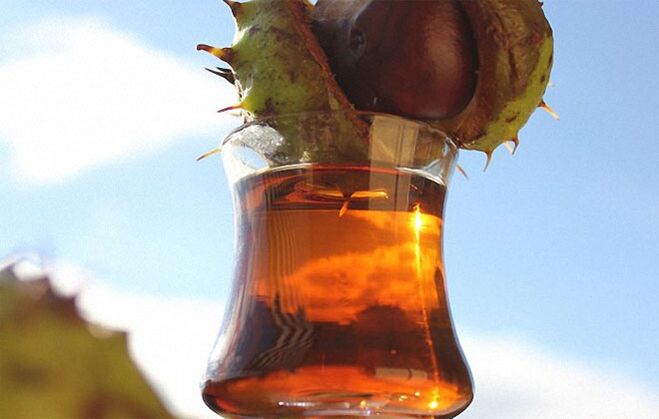
- Compresses from tomatoes.To do this, you can use tomatoes of any degree of maturity.Several fruits should be cut with rings, attach to advanced vessels and nodes, fix it.After some time, a small burning sensation should appear in this place, after which the compress should be removed and the legs should be rinse.To fight varicose veins with this method, you need to at least 2-3 weeks.
- Lemon rubbing.Citrus fruits have a pronounced tonic effect.To carry out the procedure, you need to cut a slice of lemon and rub into the epidermis.
- Tincture of horse chestnut.To prepare the medicine, the fruits must be chopped, put in a glass container.Fill with vodka or diluted alcohol to half.Place the container in a dark and cool place, periodically shake.Spend for at least 1 month.You need to take the medicine 5-10 drops 3-4 times a day.It is necessary to treat varicose veins on the legs in men with tincture of chestnut for 2-4 months.
- Apple vinegar 6%.The tool tones the vessels and strengthens their walls, helps to eliminate edema.It is used for rubbing into the skin, the procedure must be done with varicose veins regularly, for several weeks.
- Compress from Kalanchoe.It helps to remove a slight expansion of veins on the legs of men.To prepare the medicine, you need to take several leaves of the plant, grind and pour diluted alcohol.The tool insist 7-10 days.Use to apply compresses - put the mass on the cotton section of the tissue, place on the area of sick vessels, cover with a plastic bag on top, wrap and strengthen.Varicose is treated for a long time, several weeks.It is advisable to do the procedure at night so that the medicine acts as long as possible.
Before using folk methods of treating varicose veins, it is necessary to agree with a doctor.Some methods can harm more than good.
Surgical intervention
You can cure varicose veins in the only way - with the help of surgical intervention.However, any operation is accompanied by some risks, so it is desirable to resort to it only with pronounced changes from the vessels.With the help of surgical treatment, it will be possible to completely remove varicose veins.
With varicose veins, treatment is selected taking into account the characteristics of the course of the disease.The main methods:
- Laser removal.With the help of a ray, problematic veins of a small diameter are sealed.Blood circulation stops in them, over time their lumen is growing up.The uniqueness of the method consists of accuracy of exposure, the surrounding tissues are not damaged.Control is carried out using an ultrasound sensor.The procedure is low -traumatic, does not require special training, is carried out on an outpatient basis.
- Sclerotherapy.To remove varicose veins, a special substance is introduced into the lumen of the vessel - sclerosant.The drug causes a vein fusion with its subsequent resorption.The procedure is carried out without pain relief, its duration does not exceed 30-40 minutes.After manipulation, the patient should wear special compression linen for several days.Sclerotherapy is effective in the fight against vascular stars and nets, telangiectasias, dilated and knotted vessels, as well as in severe course of the disease.
- Minifle -Commission.Small punctures are carried out on the skin through which the affected vessels are removed.The procedure is carried out under local or general anesthesia.Miniflebectomy is used in the fight against winding and defective veins.
Than dangerous
Vascular diseases are systemic pathologies.The defeat of the veins of the lower extremities is easy to notice, but the process often applies to other vessels.Varicosis on the feet of women is dangerous primarily in that it can switch to the pelvic organs.This threatens the development of complications during pregnancy.And during this period, many drugs are strictly prohibited for use.
Varicosis on the legs in men is dangerous, since the process can spread to the genitals, in particular, to lead to the expansion of the veins of the seed cord.This threatens the emergence of male infertility.
Other complications of VRV are increasing the likelihood of blood clots and blockage of the lumen of blood vessels.The development of phlebitis is not excluded.The disease is dangerous and the formation of trophic ulcers.This is an open gate for infection, wounds are poorly healing due to impaired tissue blood supply.
Prevention
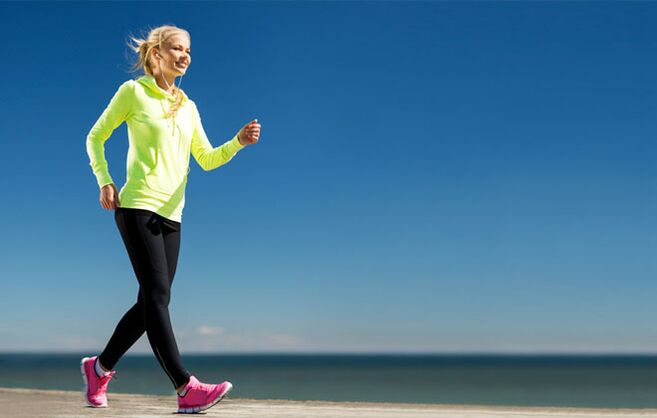
In order to prevent the development of varicose veins of the lower extremities, it is necessary to monitor health from young age.Prevention of the disease is more effective than treating the legs with the development of complications.
To have good blood circulation, it is necessary to ensure sufficient motor activity.If a person at work has been in the same position for a long time, a small warm -up should be regularly done.It is necessary to responsibly approach the choice of shoes - it should be in a small heel (not higher than 6 cm), comfortable, not to squeeze the leg.
It is necessary to monitor the weight.Excessive mass is one of the predisposing factors to the development of the disease.In addition, it leads to increased load on the blood vessels.Clothing should be made of natural fabrics.The use of too close underwear should be avoided to avoid squeezing the main vessels in the groin.
During hygiene procedures, it is advisable to use a shower, which makes it possible to change the pressure and temperature of the water.With the help of these tricks, you can tone the vessels, activate the blood flow.
It is advisable to do exercises or sports daily.It is not necessary to run a few kilometers at a time, it is enough to visit the pool for your pleasure, make foot or bike rods.
Before using hormonal contraceptives, you should consult not only a gynecologist, but also a phlebologist, take tests for hormones.If you change the level of female hormones in the blood, this can adversely affect the condition of the walls of the vessels.























